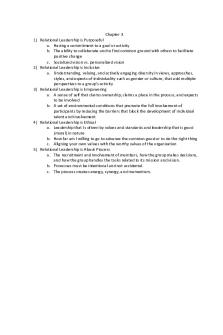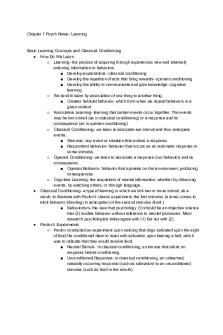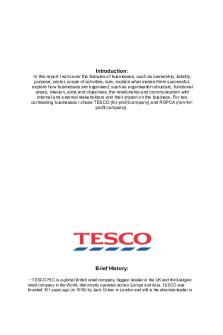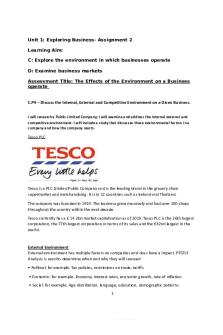Chapter 1 Notes - Summary Exploring Business PDF

| Title | Chapter 1 Notes - Summary Exploring Business |
|---|---|
| Course | Foundations of Business |
| Institution | Virginia Commonwealth University |
| Pages | 6 |
| File Size | 187.2 KB |
| File Type | |
| Total Downloads | 52 |
| Total Views | 159 |
Summary
Chapter 1 notes - functional areas of business, economics, ...
Description
Foundations of Business Chapter 1
1.1 Apples Success - Products, loyal customers, willingness to take risks, luck, & Steve Jobs 1.2 Introduction - Internet communication affects business 1.3 Getting Down to Business Profit-Making Business: Activity that provides goods and services to consumers for the purpose of making a profit Profit: Difference between the revenue that a company brings in from selling goods and services & the cost of generating this revenue Not-for Profit Organizations: organizations established to provide social or educational services. Receive funds from:
Private foundations Individuals Government agencies
For-Profit Social Enterprise: business that, beyond the profit motive, has a social mission built into its business model
TOMS – buy one pair, company donates another pair
Participants -
Owners: business idea and gather resources (money and people) Employees: work for company to reach its goals Customers
[Functional Areas of Business] Management -
Process of planning for, organizing, directing and controlling a company’s resources so that it can achieve its goals o Managers responsibility
Operations -
Person who designs and oversees the process that converts resources into good or services Responsible for ensuring products are of high quality
Marketing -
Activity, set of institutions and processes for creating, communicating, delivering and exchanging offerings that have value for customers, clients, partners and society at large Develop the benefits and features of products
Accounting
Foundations of Business Chapter 1
-
Financial advisor responsible for measuring, summarizing and communicating financial and managerial information o Financial accountants: prepare statements to help users, inside and outside of organization o Managerial accountants: prepare information for internal use only
Finance -
Activities involves in planning for, obtaining and managing a company’s funds o How much money does the company need? o How and where will it get money? o How and when should the money be paid back?
[External Forces that Influence Business Activities] -
Economy o People have money = eat out Government o Standards monitored by agencies Consumer trends Public pressure to act as good citizens
1.4 What is Economics? Economics: the study of the production, distribution and consumption of goods and services Resources: inputs used to produce outputs Land and other resources Labor Capital, buildings, equipment Entrepreneurship Factors of Production: resources ^^^^ combines to produce goods and services [Input and Output Markets]
Foundations of Business Chapter 1
Economists address these 3 questions o What goods and services should be produces to meet consumer needs? o How should they be produces and who should produce them? o Who should receive goods and services?
Economic Systems: society makes decisions about allocating resources to produce and distribute products – planned systems & free market systems Planned Systems: government control -
Communism: economic system featuring the highest level of government control over allocation and distribution Socialism: economic system falling in between communism and capitalism in terms of government control over allocation and distribution
Free Market System: Economic system in which most businesses are owned and operated by individuals -
Aka Capitalism: economic system featuring the lowest level of government control over allocation and distribution Competition determines what goods/services are produced, how they are produced and for whom
Mixed Market Economy: economic system that relies on both markets and government to allocate resource Privatization: process of converting government-owned businesses to private ownership [The US Economic System]
Mixed market system Adams The Wealth of Nations
1.5 Perfect Competition and Supply & Demand Perfect Competition: market in which many consumers buy standardized products from numerous small businesses
Foundations of Business Chapter 1
-
Buyers and sellers accept the market price Since no seller is big enough to influence price
[The Demand and Demand Curve] Demand: quantity of a product that buyers are willing to purchase at various prices. Demand Curve: graph showing the quantity to a product that will be bought at certain prices [The Supply and Supply Curve] Supply: quantity of a product that sellers are willing to sell at various prices Supply Curve: graph showing quantity of a product that will be offered for sale at certain prices [Equilibrium Price] Equilibrium Price: price at which buyers are willing to buy and sellers are willing to sell Surplus: sellers are selling way more than buyers are buying Shortage: sellers font produce enough of a produce to satisfy the demand 1.6 Monopolistic Competition, Oligopoly and Monopoly Monopolistic Competition: market in which many sellers supply differentiated products ie coke vs. pepsi Oligopoly: market in which a few sellers supply a large portion of all the products sold in the market place, few sellers Monopoly: market in which there is only one seller supplying products at regulated prices, only one seller in market Natural monopoly: monopoly in which, bc of industry’s importance to society, one seller is permitted to supply products without competition Legal monopoly: monopoly in which one seller supplies a product or technology to which it holds a patent 1.7 Measuring the Health of the Economy [Economic Goals] 1. Growth 2. High employment 3. Price stability [Economic Growth] Gross Domestic Product (GDP): measure of market value of all goods and services produced by a nation’s economy in a given year -
Change in GDP tell us information about the economy
[The Business Cycle] Business Cycle: Pattern of expansion and contraction in an economy (3-5 years or longer) 4 Phases – prosperity, recessions, depressions and recovery
Foundations of Business Chapter 1
1. Prosperity: economy expands, low unemployment, income rise, consumers buy more. Business increase production and better products 2. Recession: economic slowdown measured by a decline in GDP. 3. Depression: Severe, long-lasting recession [Employment] Full Employment: condition under which about 95% of those who want to work are employed Unemployment rate: the percentage of labor force that’s currently unemployed and actively seeking work [Price Stability] Price Stability: conditions under which the prices for products remain fairly consistent Inflation: Rise in overall price level Deflation: Decrease in overall price level [The Consumer Price Index] Consumer Price Index (CPI): index that measures inflation by measuring the prices of goods purchased by a typical consumer [Economic Indicators] Economic indicator: statistic that provides information about trends in the economy Lagging economic indicators: statistical data that measure economic trends after overall economy has changed Average length of unemployment Leading economic indicators: statistical data that predict the status of the economy 3-12 months in the future New claims for unemployment insurance Consumer confidence index: measure of optimism that consumers express about the economy as they go about their everyday lives 1.8 Government’s Role in Managing the Economy Monetary Policy: efforts exerted by the Federal Reserve System to regulate the nations money supply and interest rates Inflation o Contractionary policy: decrease money supply and raise interest rates Recessions o Expansionary policy: increase money supply and reduce interest rates Fiscal policy: governmental use of taxation and spending to influence economic conditions Inflation o government decrease spending or increase taxes, or both recession o government increase spending, reduce taxes, or both
Foundations of Business Chapter 1
Surplus: when government takes in more money in given year (through taxes) than it spends Deficit: when government spends more money than it takes in National Debt: sum of deficits, total amount of money owe by the federal government 1.9 Cases and Problems 1.10 Nike Case...
Similar Free PDFs

Assignment 1 - Exploring Business
- 16 Pages

Unit 1- Exploring Business
- 8 Pages

Unit 1-Exploring the business
- 10 Pages

Chapter 1 Summary Notes
- 3 Pages
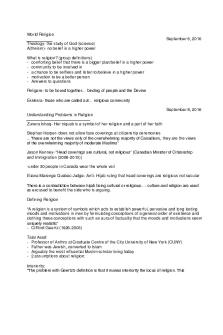
Exploring World Religions Summary
- 19 Pages
Popular Institutions
- Tinajero National High School - Annex
- Politeknik Caltex Riau
- Yokohama City University
- SGT University
- University of Al-Qadisiyah
- Divine Word College of Vigan
- Techniek College Rotterdam
- Universidade de Santiago
- Universiti Teknologi MARA Cawangan Johor Kampus Pasir Gudang
- Poltekkes Kemenkes Yogyakarta
- Baguio City National High School
- Colegio san marcos
- preparatoria uno
- Centro de Bachillerato Tecnológico Industrial y de Servicios No. 107
- Dalian Maritime University
- Quang Trung Secondary School
- Colegio Tecnológico en Informática
- Corporación Regional de Educación Superior
- Grupo CEDVA
- Dar Al Uloom University
- Centro de Estudios Preuniversitarios de la Universidad Nacional de Ingeniería
- 上智大学
- Aakash International School, Nuna Majara
- San Felipe Neri Catholic School
- Kang Chiao International School - New Taipei City
- Misamis Occidental National High School
- Institución Educativa Escuela Normal Juan Ladrilleros
- Kolehiyo ng Pantukan
- Batanes State College
- Instituto Continental
- Sekolah Menengah Kejuruan Kesehatan Kaltara (Tarakan)
- Colegio de La Inmaculada Concepcion - Cebu



